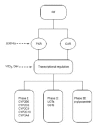Roles of rifampicin in drug-drug interactions: underlying molecular mechanisms involving the nuclear pregnane X receptor
- PMID: 16480505
- PMCID: PMC1395332
- DOI: 10.1186/1476-0711-5-3
Roles of rifampicin in drug-drug interactions: underlying molecular mechanisms involving the nuclear pregnane X receptor
Abstract
Rifampicin, an important drug in the treatment of tuberculosis, is used extensively despite its broad effects on drug-drug interactions, creating serious problems. The clinical importance of such interactions includes autoinduction leading to suboptimal or failed treatment. The concomitantly administered effects of rifampicin on other drugs can result in their altered metabolism or transportation that are metabolised by cytochromes P450 or transported by p-glycoprotein in the gastrointestinal tract and liver. This review paper summarises recent findings with emphases on the molecular mechanisms used to explain these broad drug-drug interactions. In general, rifampicin can act on a pattern: rifampicin activates the nuclear pregnane X receptor that in turn affects cytochromes P450, glucuronosyltransferases and p-glycoprotein activities. This pattern of action may explain many of the rifampicin inducing drug-drug interactions. However, effects through other mechanisms have also been reported and these make any explanation of such drug-drug interactions more complex.
Figures


References
-
- Nies AS. Principles of the therapeutics. In: Hardman JG, Limbird LE, Molinoff PB, editor. Goodman & Gilman's The Pharmacological Basis of Therapeutics. 10. New York: McGraw-Hill Inc; 2001. pp. 45–66.
Publication types
MeSH terms
Substances
LinkOut - more resources
Full Text Sources
Other Literature Sources

